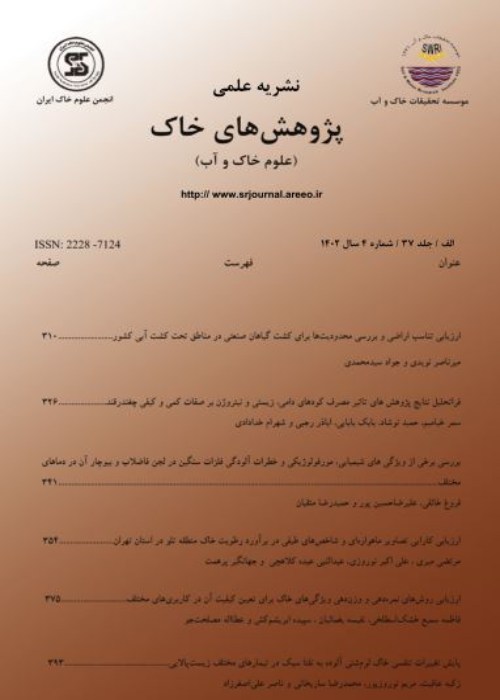Preparation and Evaluation of the Organo-Montmorillonite Clay Modified with Surfactants and Their Effects on Ammonia Production Process from Arginine in Soil
Author(s):
Article Type:
Research/Original Article (دارای رتبه معتبر)
Abstract:
Organo-clays, like organo-montmorillonite, have attracted interest in different sciences, due to their wide range of applications. In this study, three types of organo-montmorillonite clay were produced based on Cation Exchange Capacity (2 HMM, 1HMM, 0.5 HMM), using different amounts of hexadecyl trimethyl ammonium bromide surfactant. To analyze their properties, X-ray diffraction (XRD), Fourier transform infrared (FTIR) spectroscopy, and field emission scanning electron microscope (FE-SEM) were employed and clays’ dispersive capability was investigated. Results of XRD showed that the basal spacing of the treated organo-clay increased. Results of FTIR spectra also illustrated that the newly identified bands in organo-montmorillonite were due to organic surfactants. SEM morphological study of clays depicted that although the montmorillonite clay was in agglomerative form, treating with organic surfactants altered it to the shorter layers with porous surfaces. Results of XRD indicated that treatment on organo-montmorillonite changes the surface properties from hydrophilic to hydrophobic, and this affects the absorbance of organic pollutants and enzymes. This study has an important role in preparing the cheap organo-clays, employing such additives to decrease the environmental pollutants and increase the biological activities of the soil, specifically to activate the soil enzymes. Effects of applying the organo-clay on L-arginine ammonification process were then determined. Experiments were carried out using a completely randomized design with factorial arrangement employing three clay types (montmorillonite, montmorillonite intercalated with hexa decyl trimethyl ammonium bromide, and the control) for five durations (1, 3, 7, 14, and 21 days) with three replications. Results indicated that the highest ammonification of L-arginine, as an estimate of the soil microbial biomass, was in the soil samples that were treated with montmorillonite intercalated with hexa decyl trimethyl ammonium bromide (HMM) surfactant. Results indicated that the change in the soil. Environment surrounding the enzymes with the organic surfactant increased activity and stability of enzymes in soil during the 21-day incubation period.
Language:
Persian
Published:
Iranian Journal of Soil Research, Volume:37 Issue: 1, 2023
Pages:
81 to 94
magiran.com/p2587362
دانلود و مطالعه متن این مقاله با یکی از روشهای زیر امکان پذیر است:
اشتراک شخصی
با عضویت و پرداخت آنلاین حق اشتراک یکساله به مبلغ 1,390,000ريال میتوانید 70 عنوان مطلب دانلود کنید!
اشتراک سازمانی
به کتابخانه دانشگاه یا محل کار خود پیشنهاد کنید تا اشتراک سازمانی این پایگاه را برای دسترسی نامحدود همه کاربران به متن مطالب تهیه نمایند!
توجه!
- حق عضویت دریافتی صرف حمایت از نشریات عضو و نگهداری، تکمیل و توسعه مگیران میشود.
- پرداخت حق اشتراک و دانلود مقالات اجازه بازنشر آن در سایر رسانههای چاپی و دیجیتال را به کاربر نمیدهد.
In order to view content subscription is required
Personal subscription
Subscribe magiran.com for 70 € euros via PayPal and download 70 articles during a year.
Organization subscription
Please contact us to subscribe your university or library for unlimited access!


